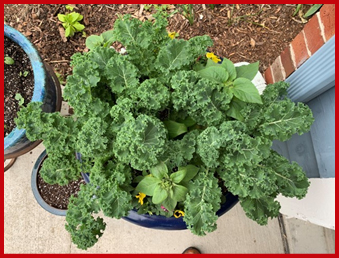Tips for growing vegetables in containers

This article was posted by the University of Wisconsin Madison Extension
Container gardening is an increasingly popular way for home gardeners to grow their favorite vegetables, particularly when gardening space is limited. Containers can be placed on a windowsill, patio, deck or balcony, or in any place where growing conditions are appropriate for producing vegetables.
Containers can be easily moved from place to place to take advantage of changing weather conditions (e.g., rain, sunlight), and their proximity to a home makes caring for plants and harvesting vegetables easy and convenient. The following are some pointers on how to ensure success when container gardening.
What types of vegetables can I grow in containers? Almost any vegetable can be grown in a container given the right variety and container size. However, determinate, dwarf and compact vegetable varieties often work best.
Vegetables like arugula, kale, lettuce and spinach work well in containers because they are easy to seed, can be harvested frequently, and can be replanted throughout the season. Smaller vegetables such as beets, carrots, radishes and turnips also grow well in containers because the loose, well-drained potting mixes used for container gardening allow roots to grow easily.
When growing root vegetables, be sure to space plants two to four inches apart to allow roots to form properly. As an added bonus, the greens of root vegetables are not large, do not need support, and are very attractive. Vining plants like cucumber, peas, melons and squash can be grown in containers with proper supports (e.g., trellises).
Alternatively, there are bush or hanging varieties of these vegetables that do well in containers. Tomatoes (properly staked or caged), peppers, and eggplant grow especially well in containers and can be mixed with herbs or flowers for added visual appeal. For a list of suggested vegetables for containers, see University of Wisconsin Garden Facts XHT1273, Vegetable Varieties for Containers.
What sort of container should I use? Choosing the right type of container for the vegetables that you decide to grow is very important. Containers should have the right volume and depth to support plants once they are fully grown.
In general, smaller plants like leaf lettuce, spinach, peas, radishes, cilantro, and green onions require containers with a volume of at least two gallons and that are at least four to six inches deep. Larger plants like tomatoes, peppers, broccoli, eggplants, squash, cucumbers and bush beans require a container with a minimum volume of five gallons and a depth of 12 to 18 inches.
Many types of containers are available for growing vegetables including (but not limited to) 5-gallon plastic buckets, plastic pots, plastic storage containers, terra cotta/clay and ceramic pots, concrete and wooden planter boxes, wooden barrels, bushel baskets, plastic bags, grow bags and self-watering containers. Make sure that the container you select has a drainage hole.
If you are reusing containers, be sure to decontaminate them prior to use, particularly if you previously have had problems with root rots (see University of Wisconsin Garden Facts XHT1072, Root Rots in the Garden) or damping-off (see University of Wisconsin Garden Facts XHT1124, Damping-Off).
Rinse pots to remove clinging bits of soil, then soak them in 10% bleach (a formulation designed to disinfect) for 30 minutes. Then rinse containers to remove any bleach residue. This treatment may not consistently be effective for plastic containers. You may have to replace these containers if disease issues persist.
What sort of soil should I use? Commercial potting mixes work well for most vegetables. They are typically light weight, high in organic matter and well-drained, containing a combination of compost, peat moss, bark, perlite or other similar materials. Read the label before purchasing a potting mix to determine its composition.
When possible, select a product that has been pasteurized to reduce the risk of diseases caused by soil-borne pathogens. Consider adding a slow-release fertilizer, if there is not one included in the mix. Bagged potting mixes come in easy-to-handle sizes: 1, 2, or 2.8 cubic feet (7.5, 15 and 21 gallons respectively).
Fill your container completely with planting mix for optimal drainage. DO NOT put anything (e.g., rocks, broken pot pieces, etc.) in the bottom of the pot. Research shows layering materials in a container impedes drainage; water moves best through a continuous column of soil mix.
 Leafy vegetables like kale are easy to seed in containers, can be harvested frequently, and can be reseeded throughout the season.
Leafy vegetables like kale are easy to seed in containers, can be harvested frequently, and can be reseeded throughout the season.
How do I care for my plants? Place your containerized plants in full sun (i.e., a minimum of six hours per day) with easy access to water. Initially, when plants are small, you will not need to water much.
However, as plants increase in size, the temperature increases, and the plants start to produce fruit (e.g., tomatoes, peppers, eggplants, zucchinis, cucumbers), you will need to water daily.
You may also need to fertilize. If so, use a fertilizer designed for growing vegetables, and follow the instructions on the label to determine how much and how frequently to apply.
Harvest leafy greens such as kale, mustard and lettuce on a regular basis, and reseed as needed. If plants fail, remove and replace them with other vegetables that fit the space and have time to grow to harvest. Greens, radishes, bush beans, and cilantro are fast-growing filler vegetables that you can grow from seed.

































